Accounting Standards and Regulations: Myer's Asset Impairment
VerifiedAdded on 2020/02/24
|10
|1876
|38
Report
AI Summary
This report provides an in-depth analysis of Myer's asset impairment, adhering to Accounting Standards and Regulations, specifically AASB 136 and IAS 36. The report examines the required evidence for asset impairment testing, focusing on asset flow, asset base, and asset turnover. It outlines the procedures for determining impairment, including the use of a discounted cash flow model with key assumptions such as the pre-tax rate of discount, terminal growth rate, and operational gross profit margin. The report also details the information required for impairment determination, emphasizing the recoverable amount and the treatment of goodwill and intangible assets. Furthermore, it explores the flexibility available to Myer's management in conducting asset impairment tests, highlighting their role in assessing the carrying value of stores and determining future cash flows. The analysis concludes that there is no indication of asset impairment at Myer's stores for the year ended 2016, demonstrating compliance with accounting standards and regulations.
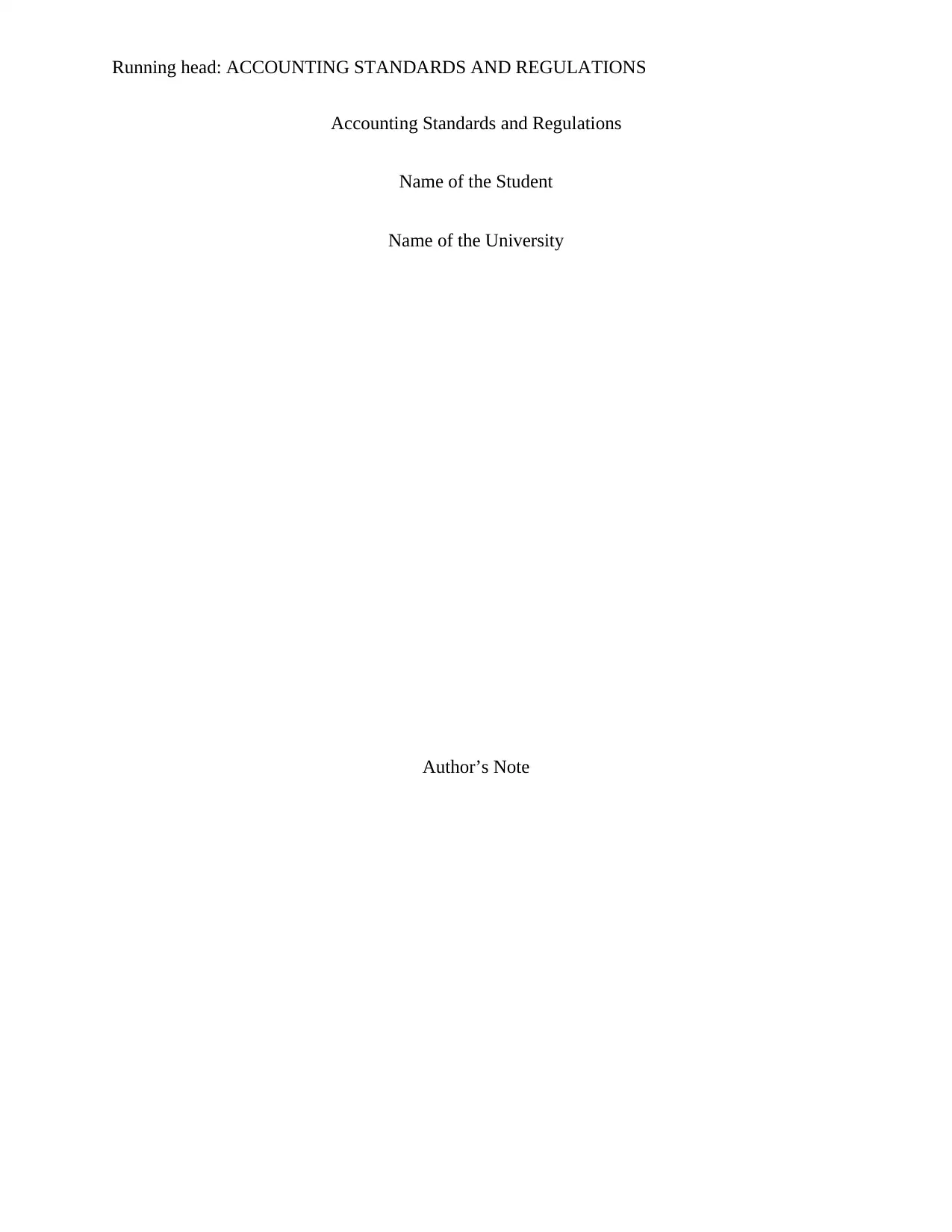
Running head: ACCOUNTING STANDARDS AND REGULATIONS
Accounting Standards and Regulations
Name of the Student
Name of the University
Author’s Note
Accounting Standards and Regulations
Name of the Student
Name of the University
Author’s Note
Paraphrase This Document
Need a fresh take? Get an instant paraphrase of this document with our AI Paraphraser
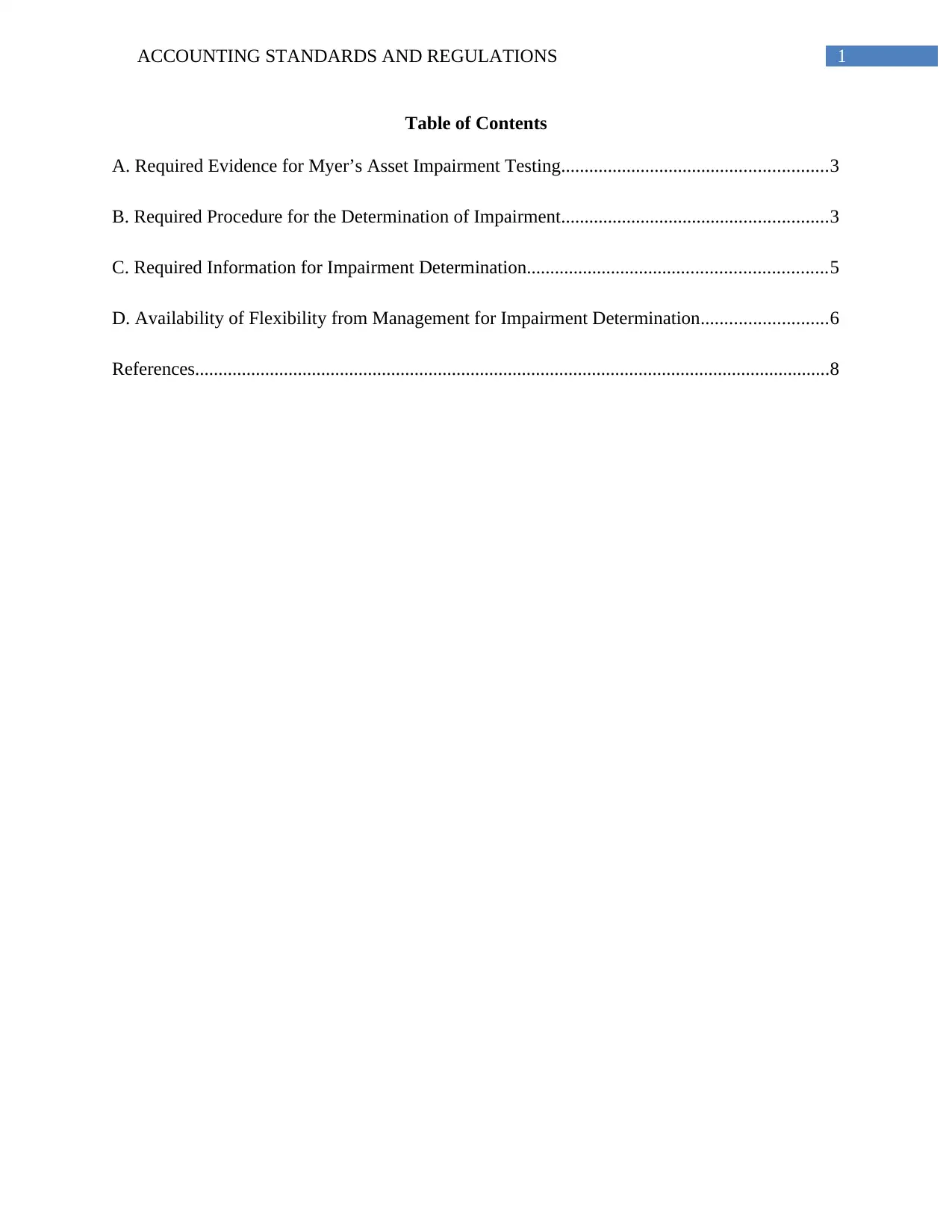
1ACCOUNTING STANDARDS AND REGULATIONS
Table of Contents
A. Required Evidence for Myer’s Asset Impairment Testing.........................................................3
B. Required Procedure for the Determination of Impairment.........................................................3
C. Required Information for Impairment Determination................................................................5
D. Availability of Flexibility from Management for Impairment Determination...........................6
References........................................................................................................................................8
Table of Contents
A. Required Evidence for Myer’s Asset Impairment Testing.........................................................3
B. Required Procedure for the Determination of Impairment.........................................................3
C. Required Information for Impairment Determination................................................................5
D. Availability of Flexibility from Management for Impairment Determination...........................6
References........................................................................................................................................8
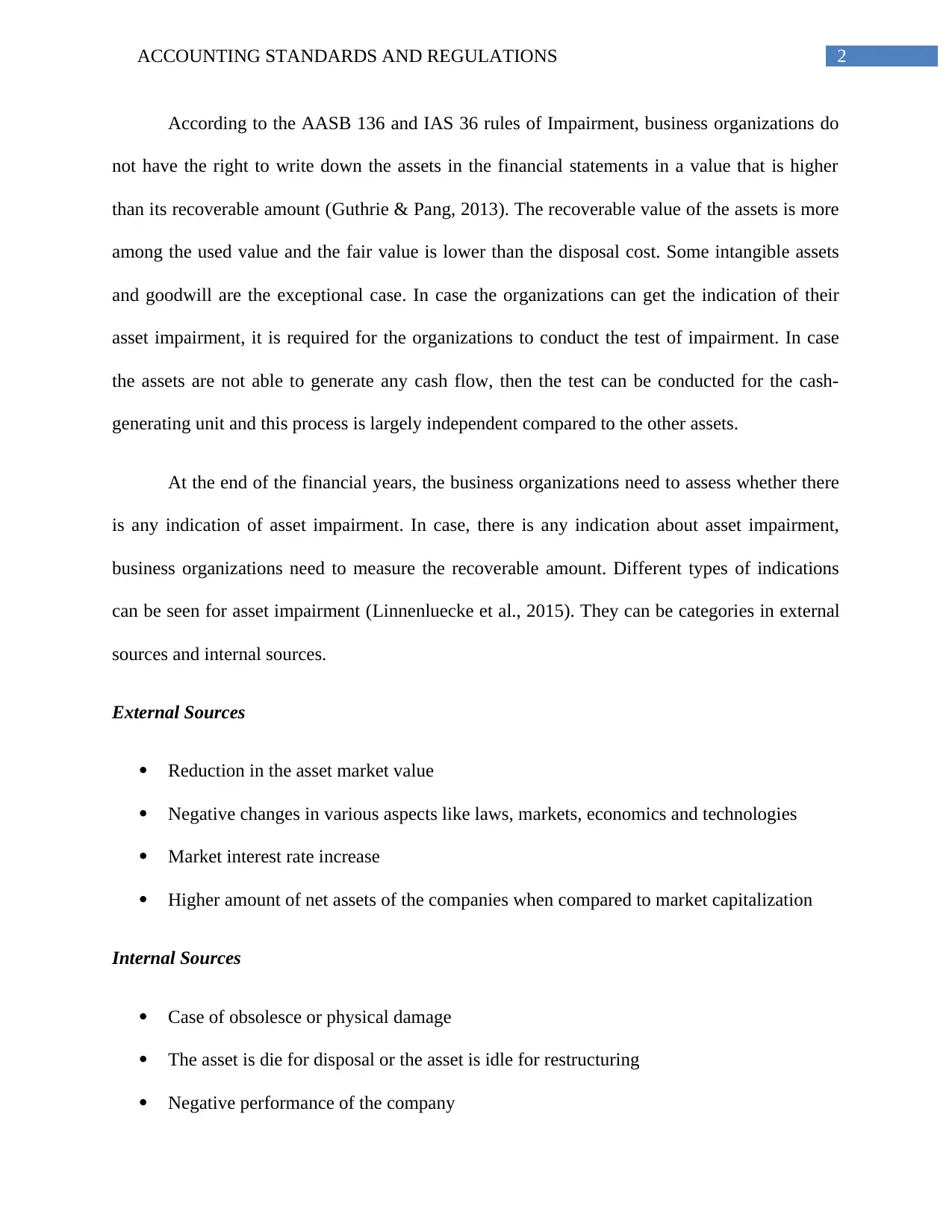
2ACCOUNTING STANDARDS AND REGULATIONS
According to the AASB 136 and IAS 36 rules of Impairment, business organizations do
not have the right to write down the assets in the financial statements in a value that is higher
than its recoverable amount (Guthrie & Pang, 2013). The recoverable value of the assets is more
among the used value and the fair value is lower than the disposal cost. Some intangible assets
and goodwill are the exceptional case. In case the organizations can get the indication of their
asset impairment, it is required for the organizations to conduct the test of impairment. In case
the assets are not able to generate any cash flow, then the test can be conducted for the cash-
generating unit and this process is largely independent compared to the other assets.
At the end of the financial years, the business organizations need to assess whether there
is any indication of asset impairment. In case, there is any indication about asset impairment,
business organizations need to measure the recoverable amount. Different types of indications
can be seen for asset impairment (Linnenluecke et al., 2015). They can be categories in external
sources and internal sources.
External Sources
Reduction in the asset market value
Negative changes in various aspects like laws, markets, economics and technologies
Market interest rate increase
Higher amount of net assets of the companies when compared to market capitalization
Internal Sources
Case of obsolesce or physical damage
The asset is die for disposal or the asset is idle for restructuring
Negative performance of the company
According to the AASB 136 and IAS 36 rules of Impairment, business organizations do
not have the right to write down the assets in the financial statements in a value that is higher
than its recoverable amount (Guthrie & Pang, 2013). The recoverable value of the assets is more
among the used value and the fair value is lower than the disposal cost. Some intangible assets
and goodwill are the exceptional case. In case the organizations can get the indication of their
asset impairment, it is required for the organizations to conduct the test of impairment. In case
the assets are not able to generate any cash flow, then the test can be conducted for the cash-
generating unit and this process is largely independent compared to the other assets.
At the end of the financial years, the business organizations need to assess whether there
is any indication of asset impairment. In case, there is any indication about asset impairment,
business organizations need to measure the recoverable amount. Different types of indications
can be seen for asset impairment (Linnenluecke et al., 2015). They can be categories in external
sources and internal sources.
External Sources
Reduction in the asset market value
Negative changes in various aspects like laws, markets, economics and technologies
Market interest rate increase
Higher amount of net assets of the companies when compared to market capitalization
Internal Sources
Case of obsolesce or physical damage
The asset is die for disposal or the asset is idle for restructuring
Negative performance of the company
⊘ This is a preview!⊘
Do you want full access?
Subscribe today to unlock all pages.

Trusted by 1+ million students worldwide
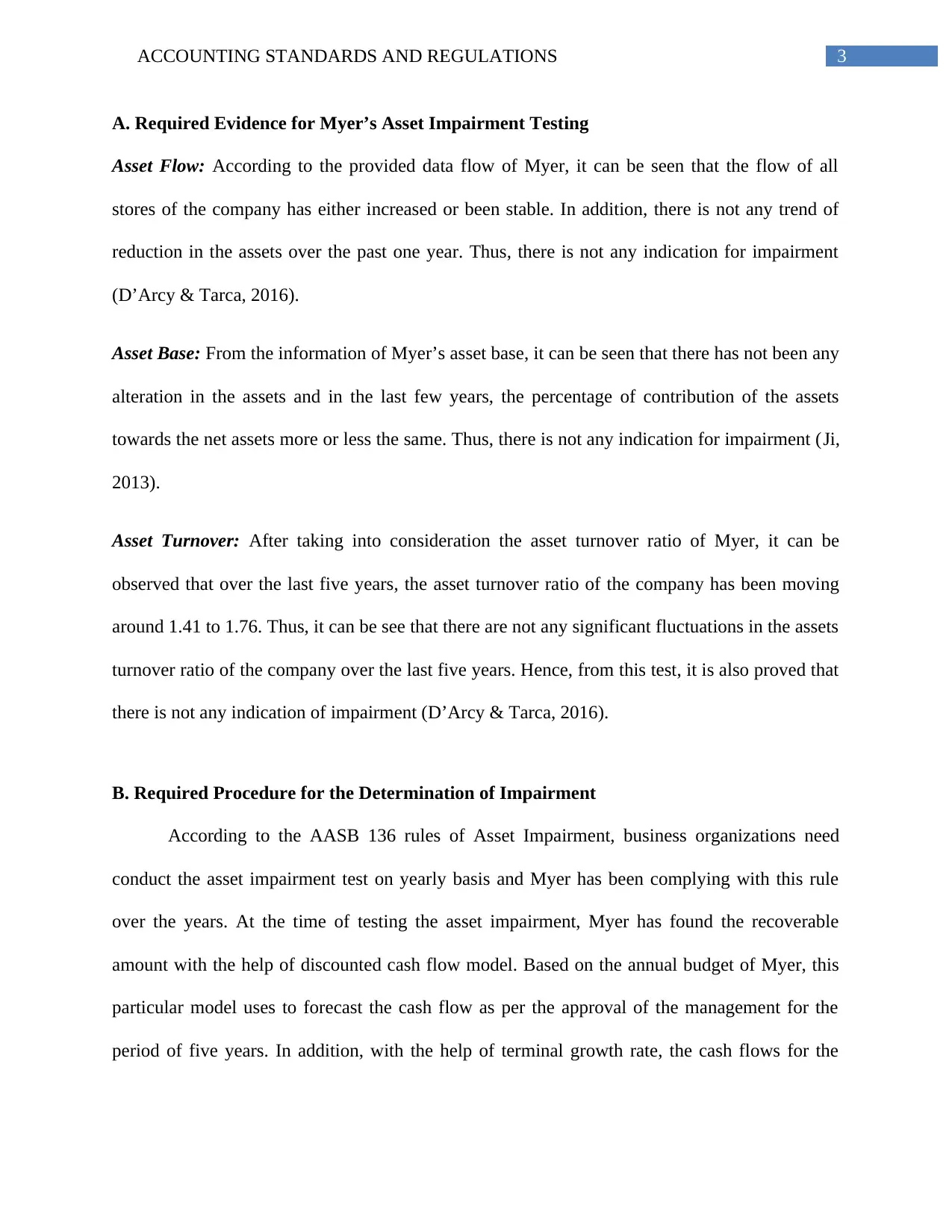
3ACCOUNTING STANDARDS AND REGULATIONS
A. Required Evidence for Myer’s Asset Impairment Testing
Asset Flow: According to the provided data flow of Myer, it can be seen that the flow of all
stores of the company has either increased or been stable. In addition, there is not any trend of
reduction in the assets over the past one year. Thus, there is not any indication for impairment
(D’Arcy & Tarca, 2016).
Asset Base: From the information of Myer’s asset base, it can be seen that there has not been any
alteration in the assets and in the last few years, the percentage of contribution of the assets
towards the net assets more or less the same. Thus, there is not any indication for impairment (Ji,
2013).
Asset Turnover: After taking into consideration the asset turnover ratio of Myer, it can be
observed that over the last five years, the asset turnover ratio of the company has been moving
around 1.41 to 1.76. Thus, it can be see that there are not any significant fluctuations in the assets
turnover ratio of the company over the last five years. Hence, from this test, it is also proved that
there is not any indication of impairment (D’Arcy & Tarca, 2016).
B. Required Procedure for the Determination of Impairment
According to the AASB 136 rules of Asset Impairment, business organizations need
conduct the asset impairment test on yearly basis and Myer has been complying with this rule
over the years. At the time of testing the asset impairment, Myer has found the recoverable
amount with the help of discounted cash flow model. Based on the annual budget of Myer, this
particular model uses to forecast the cash flow as per the approval of the management for the
period of five years. In addition, with the help of terminal growth rate, the cash flows for the
A. Required Evidence for Myer’s Asset Impairment Testing
Asset Flow: According to the provided data flow of Myer, it can be seen that the flow of all
stores of the company has either increased or been stable. In addition, there is not any trend of
reduction in the assets over the past one year. Thus, there is not any indication for impairment
(D’Arcy & Tarca, 2016).
Asset Base: From the information of Myer’s asset base, it can be seen that there has not been any
alteration in the assets and in the last few years, the percentage of contribution of the assets
towards the net assets more or less the same. Thus, there is not any indication for impairment (Ji,
2013).
Asset Turnover: After taking into consideration the asset turnover ratio of Myer, it can be
observed that over the last five years, the asset turnover ratio of the company has been moving
around 1.41 to 1.76. Thus, it can be see that there are not any significant fluctuations in the assets
turnover ratio of the company over the last five years. Hence, from this test, it is also proved that
there is not any indication of impairment (D’Arcy & Tarca, 2016).
B. Required Procedure for the Determination of Impairment
According to the AASB 136 rules of Asset Impairment, business organizations need
conduct the asset impairment test on yearly basis and Myer has been complying with this rule
over the years. At the time of testing the asset impairment, Myer has found the recoverable
amount with the help of discounted cash flow model. Based on the annual budget of Myer, this
particular model uses to forecast the cash flow as per the approval of the management for the
period of five years. In addition, with the help of terminal growth rate, the cash flows for the
Paraphrase This Document
Need a fresh take? Get an instant paraphrase of this document with our AI Paraphraser
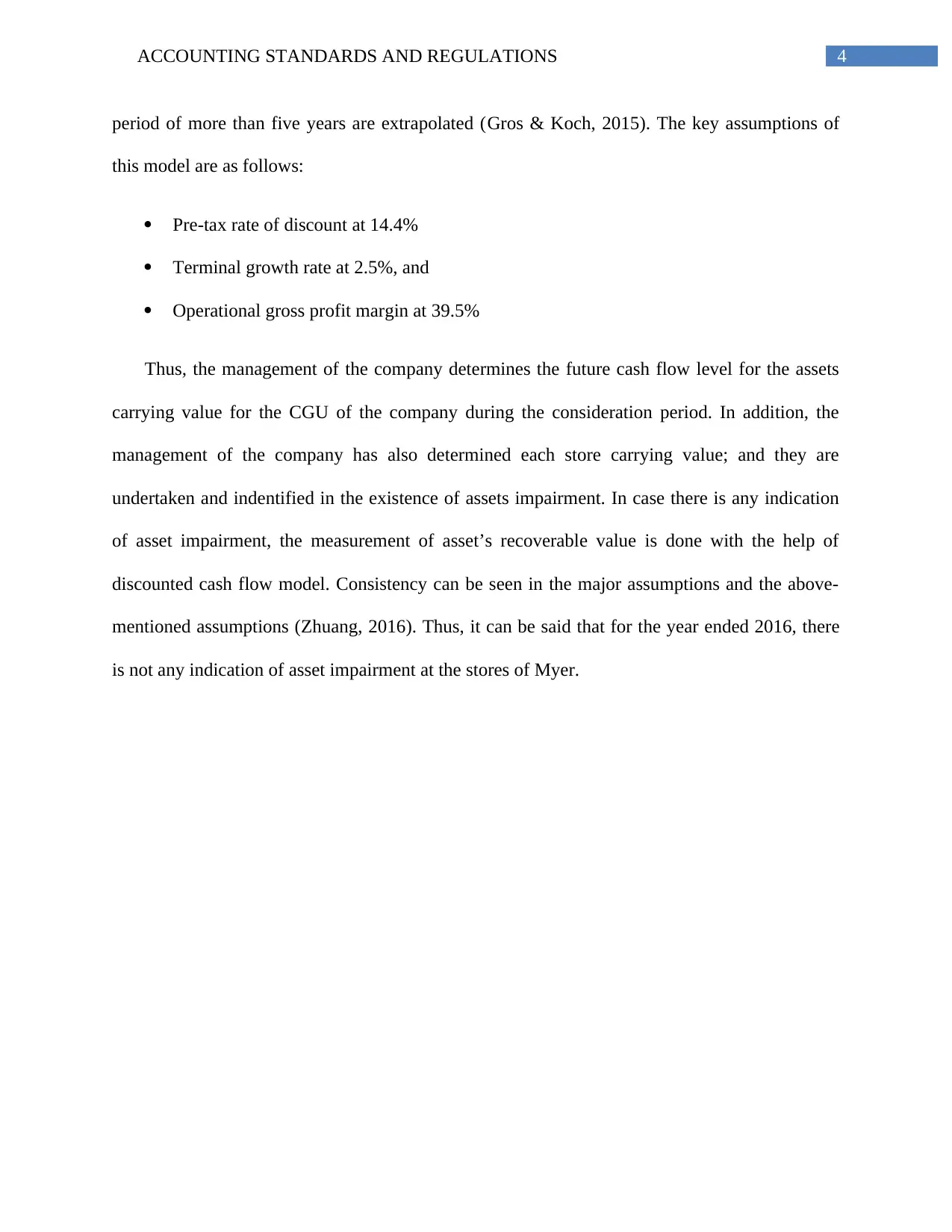
4ACCOUNTING STANDARDS AND REGULATIONS
period of more than five years are extrapolated (Gros & Koch, 2015). The key assumptions of
this model are as follows:
Pre-tax rate of discount at 14.4%
Terminal growth rate at 2.5%, and
Operational gross profit margin at 39.5%
Thus, the management of the company determines the future cash flow level for the assets
carrying value for the CGU of the company during the consideration period. In addition, the
management of the company has also determined each store carrying value; and they are
undertaken and indentified in the existence of assets impairment. In case there is any indication
of asset impairment, the measurement of asset’s recoverable value is done with the help of
discounted cash flow model. Consistency can be seen in the major assumptions and the above-
mentioned assumptions (Zhuang, 2016). Thus, it can be said that for the year ended 2016, there
is not any indication of asset impairment at the stores of Myer.
period of more than five years are extrapolated (Gros & Koch, 2015). The key assumptions of
this model are as follows:
Pre-tax rate of discount at 14.4%
Terminal growth rate at 2.5%, and
Operational gross profit margin at 39.5%
Thus, the management of the company determines the future cash flow level for the assets
carrying value for the CGU of the company during the consideration period. In addition, the
management of the company has also determined each store carrying value; and they are
undertaken and indentified in the existence of assets impairment. In case there is any indication
of asset impairment, the measurement of asset’s recoverable value is done with the help of
discounted cash flow model. Consistency can be seen in the major assumptions and the above-
mentioned assumptions (Zhuang, 2016). Thus, it can be said that for the year ended 2016, there
is not any indication of asset impairment at the stores of Myer.
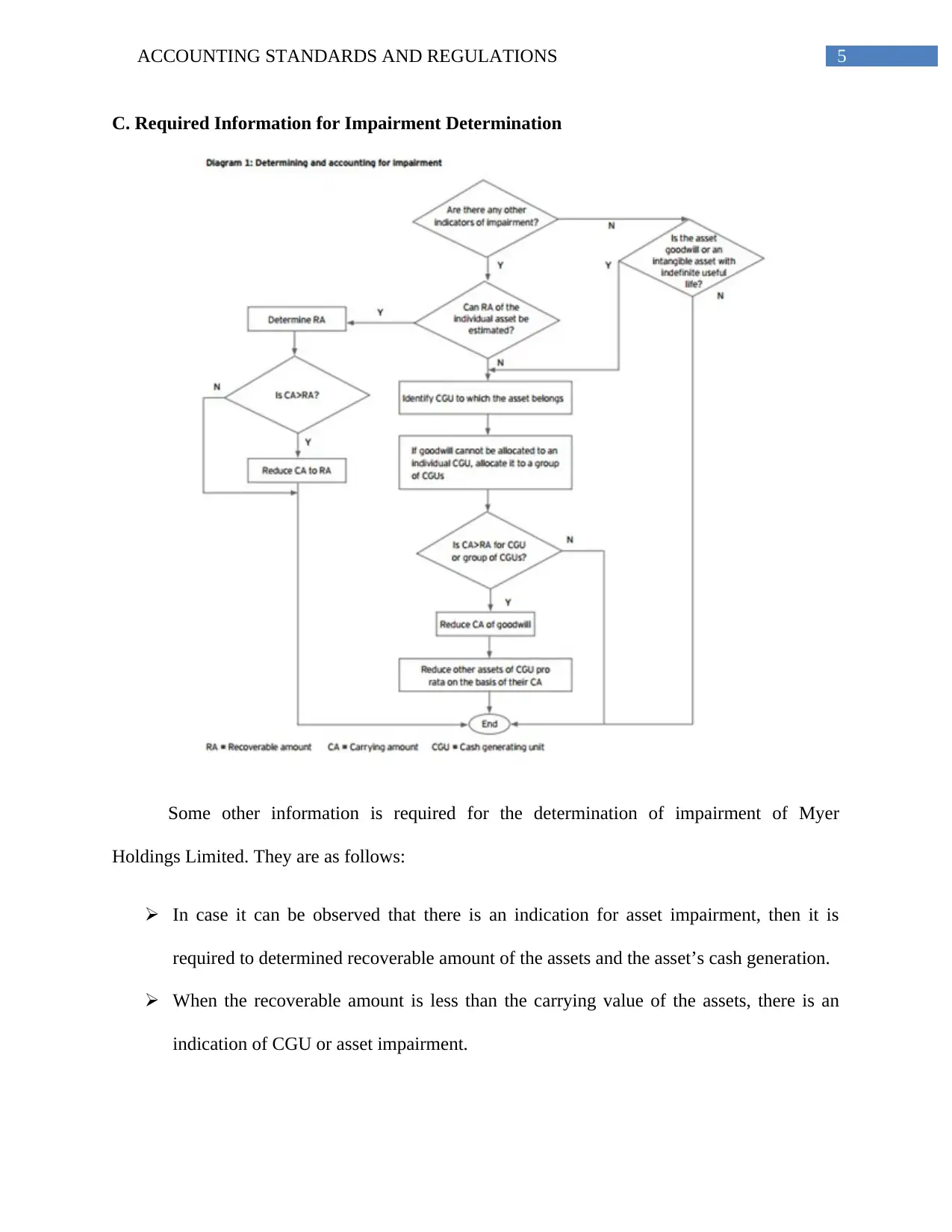
5ACCOUNTING STANDARDS AND REGULATIONS
C. Required Information for Impairment Determination
Some other information is required for the determination of impairment of Myer
Holdings Limited. They are as follows:
In case it can be observed that there is an indication for asset impairment, then it is
required to determined recoverable amount of the assets and the asset’s cash generation.
When the recoverable amount is less than the carrying value of the assets, there is an
indication of CGU or asset impairment.
C. Required Information for Impairment Determination
Some other information is required for the determination of impairment of Myer
Holdings Limited. They are as follows:
In case it can be observed that there is an indication for asset impairment, then it is
required to determined recoverable amount of the assets and the asset’s cash generation.
When the recoverable amount is less than the carrying value of the assets, there is an
indication of CGU or asset impairment.
⊘ This is a preview!⊘
Do you want full access?
Subscribe today to unlock all pages.

Trusted by 1+ million students worldwide
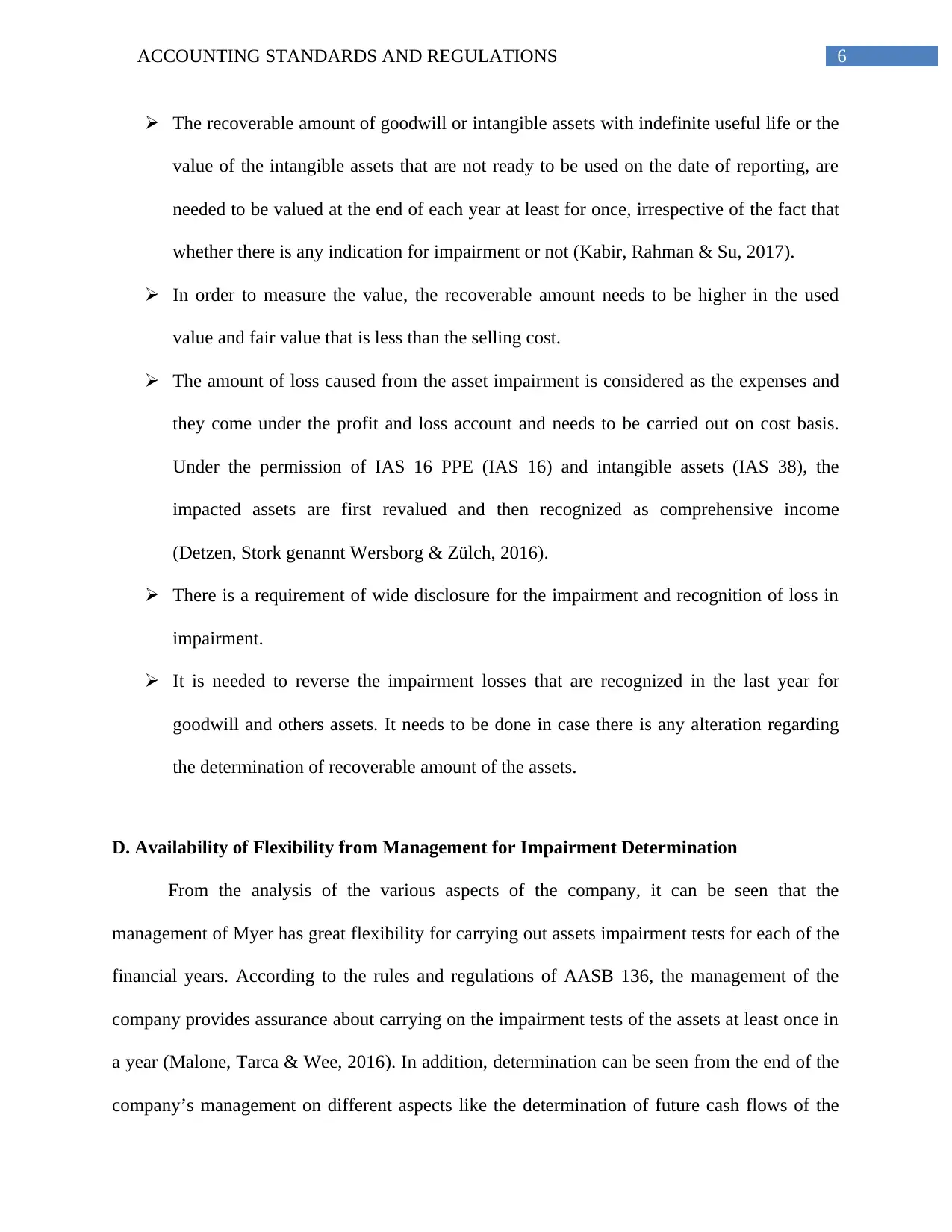
6ACCOUNTING STANDARDS AND REGULATIONS
The recoverable amount of goodwill or intangible assets with indefinite useful life or the
value of the intangible assets that are not ready to be used on the date of reporting, are
needed to be valued at the end of each year at least for once, irrespective of the fact that
whether there is any indication for impairment or not (Kabir, Rahman & Su, 2017).
In order to measure the value, the recoverable amount needs to be higher in the used
value and fair value that is less than the selling cost.
The amount of loss caused from the asset impairment is considered as the expenses and
they come under the profit and loss account and needs to be carried out on cost basis.
Under the permission of IAS 16 PPE (IAS 16) and intangible assets (IAS 38), the
impacted assets are first revalued and then recognized as comprehensive income
(Detzen, Stork genannt Wersborg & Zülch, 2016).
There is a requirement of wide disclosure for the impairment and recognition of loss in
impairment.
It is needed to reverse the impairment losses that are recognized in the last year for
goodwill and others assets. It needs to be done in case there is any alteration regarding
the determination of recoverable amount of the assets.
D. Availability of Flexibility from Management for Impairment Determination
From the analysis of the various aspects of the company, it can be seen that the
management of Myer has great flexibility for carrying out assets impairment tests for each of the
financial years. According to the rules and regulations of AASB 136, the management of the
company provides assurance about carrying on the impairment tests of the assets at least once in
a year (Malone, Tarca & Wee, 2016). In addition, determination can be seen from the end of the
company’s management on different aspects like the determination of future cash flows of the
The recoverable amount of goodwill or intangible assets with indefinite useful life or the
value of the intangible assets that are not ready to be used on the date of reporting, are
needed to be valued at the end of each year at least for once, irrespective of the fact that
whether there is any indication for impairment or not (Kabir, Rahman & Su, 2017).
In order to measure the value, the recoverable amount needs to be higher in the used
value and fair value that is less than the selling cost.
The amount of loss caused from the asset impairment is considered as the expenses and
they come under the profit and loss account and needs to be carried out on cost basis.
Under the permission of IAS 16 PPE (IAS 16) and intangible assets (IAS 38), the
impacted assets are first revalued and then recognized as comprehensive income
(Detzen, Stork genannt Wersborg & Zülch, 2016).
There is a requirement of wide disclosure for the impairment and recognition of loss in
impairment.
It is needed to reverse the impairment losses that are recognized in the last year for
goodwill and others assets. It needs to be done in case there is any alteration regarding
the determination of recoverable amount of the assets.
D. Availability of Flexibility from Management for Impairment Determination
From the analysis of the various aspects of the company, it can be seen that the
management of Myer has great flexibility for carrying out assets impairment tests for each of the
financial years. According to the rules and regulations of AASB 136, the management of the
company provides assurance about carrying on the impairment tests of the assets at least once in
a year (Malone, Tarca & Wee, 2016). In addition, determination can be seen from the end of the
company’s management on different aspects like the determination of future cash flows of the
Paraphrase This Document
Need a fresh take? Get an instant paraphrase of this document with our AI Paraphraser
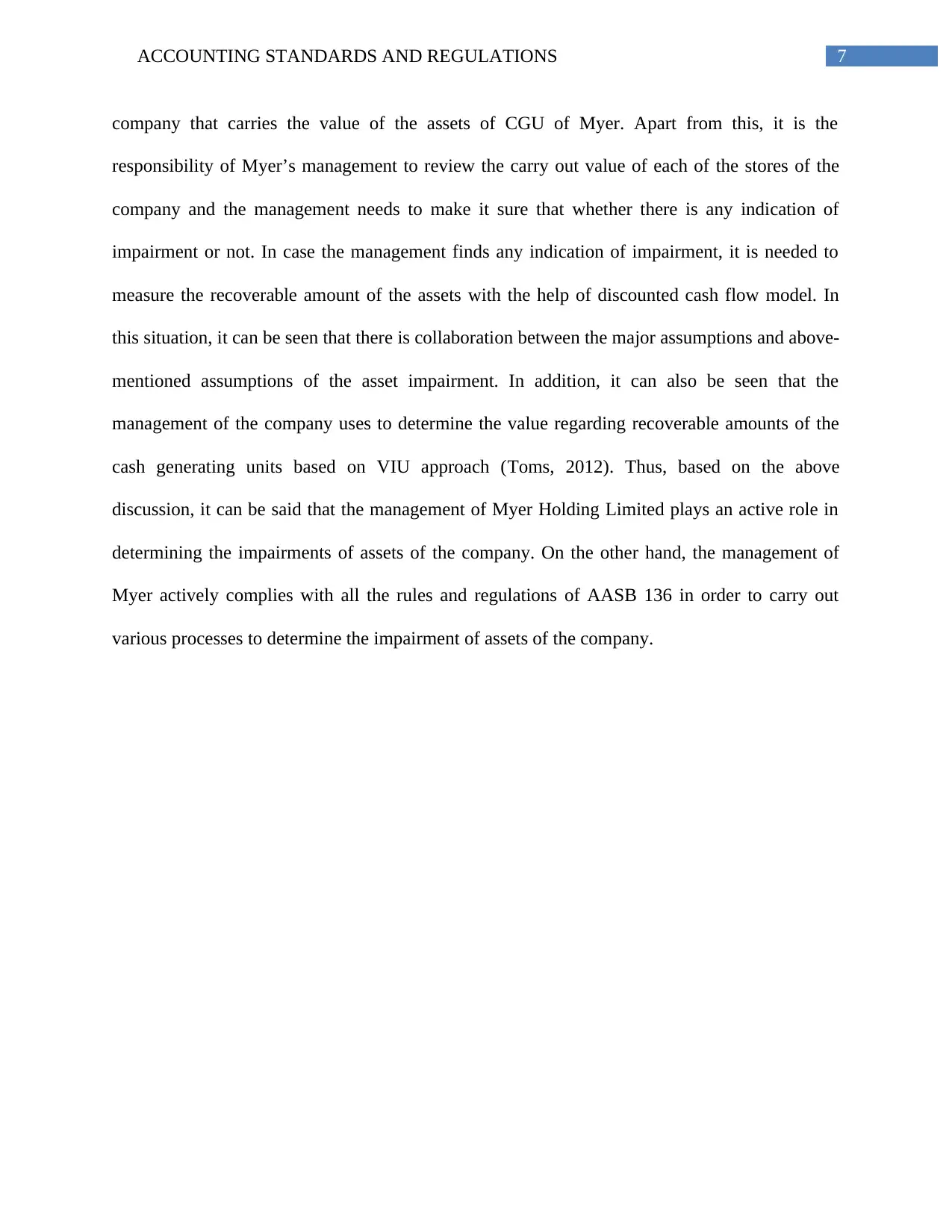
7ACCOUNTING STANDARDS AND REGULATIONS
company that carries the value of the assets of CGU of Myer. Apart from this, it is the
responsibility of Myer’s management to review the carry out value of each of the stores of the
company and the management needs to make it sure that whether there is any indication of
impairment or not. In case the management finds any indication of impairment, it is needed to
measure the recoverable amount of the assets with the help of discounted cash flow model. In
this situation, it can be seen that there is collaboration between the major assumptions and above-
mentioned assumptions of the asset impairment. In addition, it can also be seen that the
management of the company uses to determine the value regarding recoverable amounts of the
cash generating units based on VIU approach (Toms, 2012). Thus, based on the above
discussion, it can be said that the management of Myer Holding Limited plays an active role in
determining the impairments of assets of the company. On the other hand, the management of
Myer actively complies with all the rules and regulations of AASB 136 in order to carry out
various processes to determine the impairment of assets of the company.
company that carries the value of the assets of CGU of Myer. Apart from this, it is the
responsibility of Myer’s management to review the carry out value of each of the stores of the
company and the management needs to make it sure that whether there is any indication of
impairment or not. In case the management finds any indication of impairment, it is needed to
measure the recoverable amount of the assets with the help of discounted cash flow model. In
this situation, it can be seen that there is collaboration between the major assumptions and above-
mentioned assumptions of the asset impairment. In addition, it can also be seen that the
management of the company uses to determine the value regarding recoverable amounts of the
cash generating units based on VIU approach (Toms, 2012). Thus, based on the above
discussion, it can be said that the management of Myer Holding Limited plays an active role in
determining the impairments of assets of the company. On the other hand, the management of
Myer actively complies with all the rules and regulations of AASB 136 in order to carry out
various processes to determine the impairment of assets of the company.
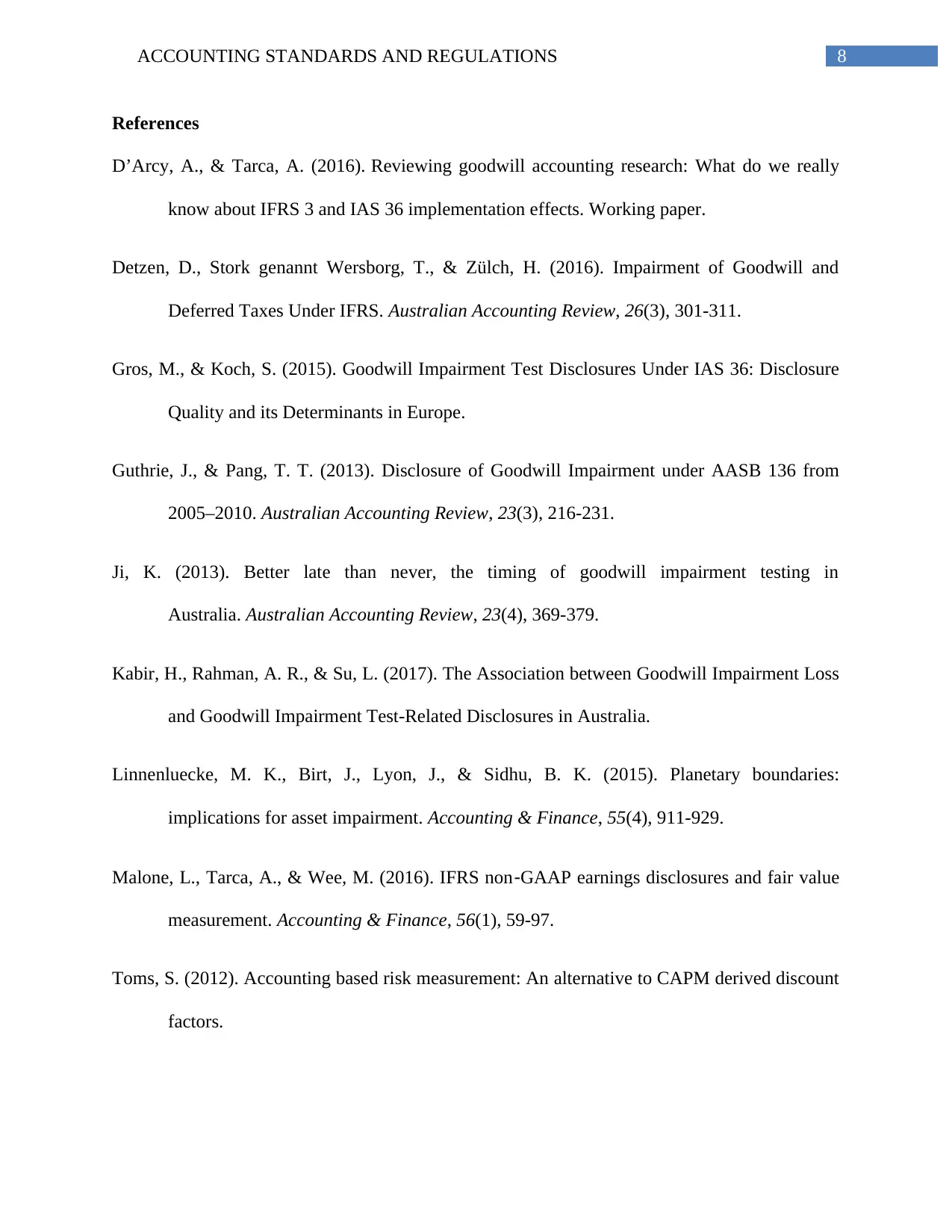
8ACCOUNTING STANDARDS AND REGULATIONS
References
D’Arcy, A., & Tarca, A. (2016). Reviewing goodwill accounting research: What do we really
know about IFRS 3 and IAS 36 implementation effects. Working paper.
Detzen, D., Stork genannt Wersborg, T., & Zülch, H. (2016). Impairment of Goodwill and
Deferred Taxes Under IFRS. Australian Accounting Review, 26(3), 301-311.
Gros, M., & Koch, S. (2015). Goodwill Impairment Test Disclosures Under IAS 36: Disclosure
Quality and its Determinants in Europe.
Guthrie, J., & Pang, T. T. (2013). Disclosure of Goodwill Impairment under AASB 136 from
2005–2010. Australian Accounting Review, 23(3), 216-231.
Ji, K. (2013). Better late than never, the timing of goodwill impairment testing in
Australia. Australian Accounting Review, 23(4), 369-379.
Kabir, H., Rahman, A. R., & Su, L. (2017). The Association between Goodwill Impairment Loss
and Goodwill Impairment Test-Related Disclosures in Australia.
Linnenluecke, M. K., Birt, J., Lyon, J., & Sidhu, B. K. (2015). Planetary boundaries:
implications for asset impairment. Accounting & Finance, 55(4), 911-929.
Malone, L., Tarca, A., & Wee, M. (2016). IFRS non‐GAAP earnings disclosures and fair value
measurement. Accounting & Finance, 56(1), 59-97.
Toms, S. (2012). Accounting based risk measurement: An alternative to CAPM derived discount
factors.
References
D’Arcy, A., & Tarca, A. (2016). Reviewing goodwill accounting research: What do we really
know about IFRS 3 and IAS 36 implementation effects. Working paper.
Detzen, D., Stork genannt Wersborg, T., & Zülch, H. (2016). Impairment of Goodwill and
Deferred Taxes Under IFRS. Australian Accounting Review, 26(3), 301-311.
Gros, M., & Koch, S. (2015). Goodwill Impairment Test Disclosures Under IAS 36: Disclosure
Quality and its Determinants in Europe.
Guthrie, J., & Pang, T. T. (2013). Disclosure of Goodwill Impairment under AASB 136 from
2005–2010. Australian Accounting Review, 23(3), 216-231.
Ji, K. (2013). Better late than never, the timing of goodwill impairment testing in
Australia. Australian Accounting Review, 23(4), 369-379.
Kabir, H., Rahman, A. R., & Su, L. (2017). The Association between Goodwill Impairment Loss
and Goodwill Impairment Test-Related Disclosures in Australia.
Linnenluecke, M. K., Birt, J., Lyon, J., & Sidhu, B. K. (2015). Planetary boundaries:
implications for asset impairment. Accounting & Finance, 55(4), 911-929.
Malone, L., Tarca, A., & Wee, M. (2016). IFRS non‐GAAP earnings disclosures and fair value
measurement. Accounting & Finance, 56(1), 59-97.
Toms, S. (2012). Accounting based risk measurement: An alternative to CAPM derived discount
factors.
⊘ This is a preview!⊘
Do you want full access?
Subscribe today to unlock all pages.

Trusted by 1+ million students worldwide
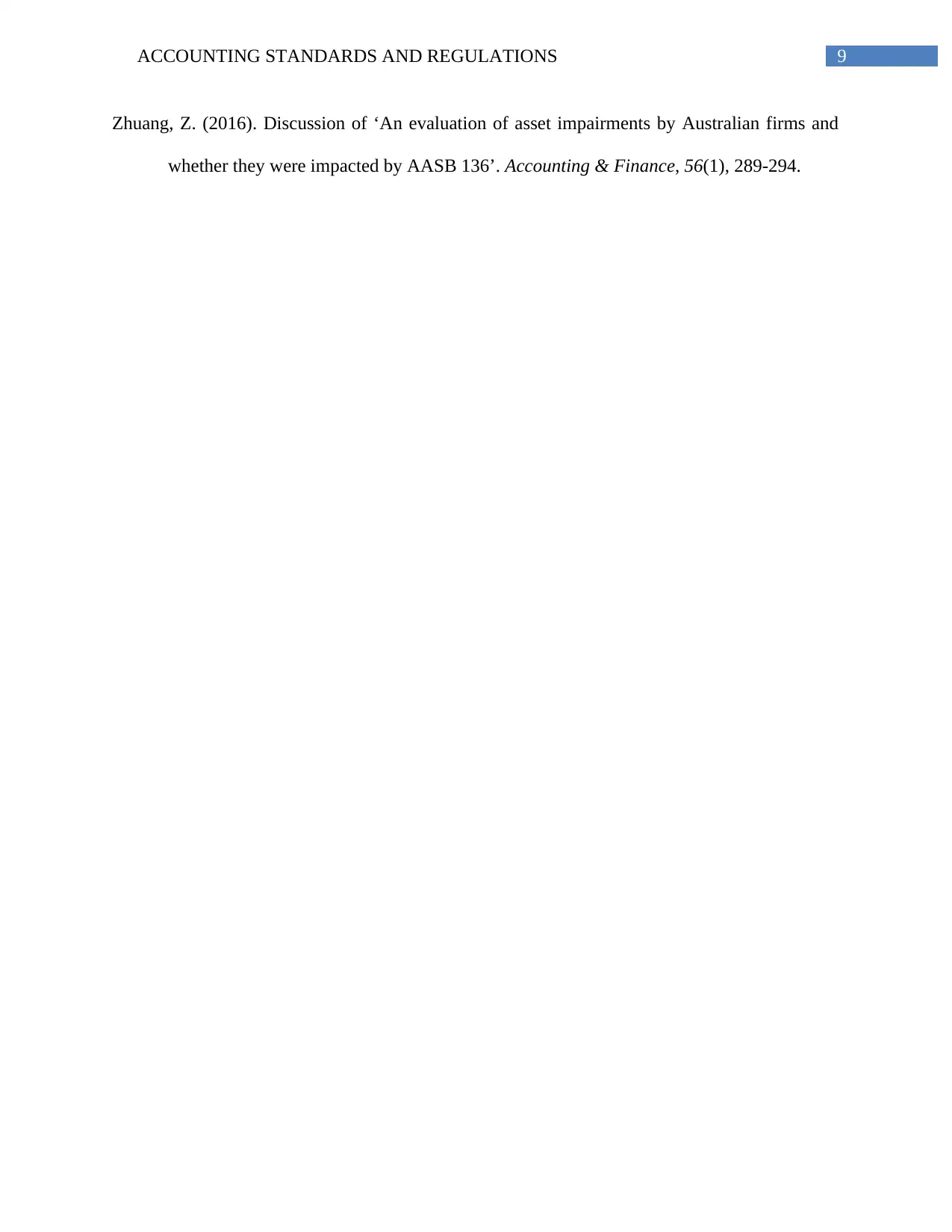
9ACCOUNTING STANDARDS AND REGULATIONS
Zhuang, Z. (2016). Discussion of ‘An evaluation of asset impairments by Australian firms and
whether they were impacted by AASB 136’. Accounting & Finance, 56(1), 289-294.
Zhuang, Z. (2016). Discussion of ‘An evaluation of asset impairments by Australian firms and
whether they were impacted by AASB 136’. Accounting & Finance, 56(1), 289-294.
1 out of 10
Related Documents
Your All-in-One AI-Powered Toolkit for Academic Success.
+13062052269
info@desklib.com
Available 24*7 on WhatsApp / Email
![[object Object]](/_next/static/media/star-bottom.7253800d.svg)
Unlock your academic potential
Copyright © 2020–2025 A2Z Services. All Rights Reserved. Developed and managed by ZUCOL.





